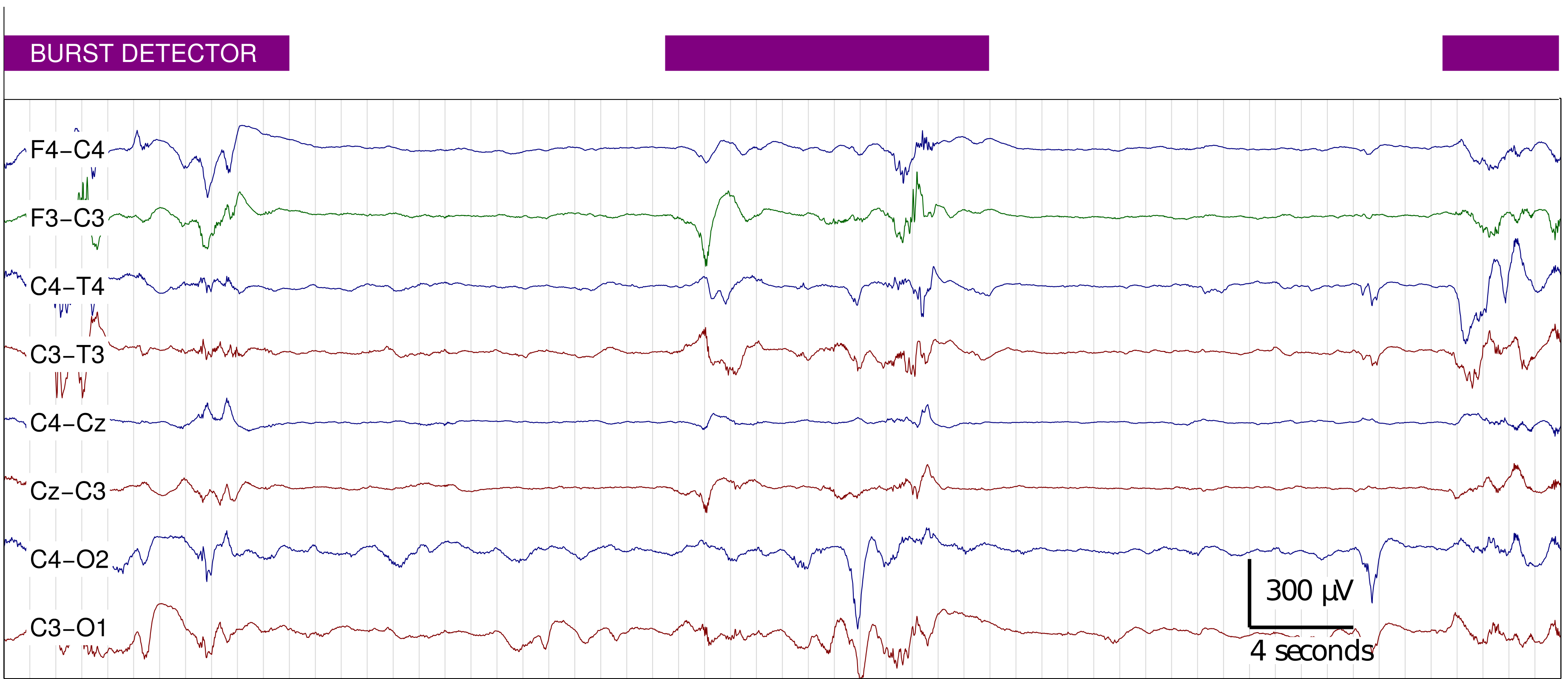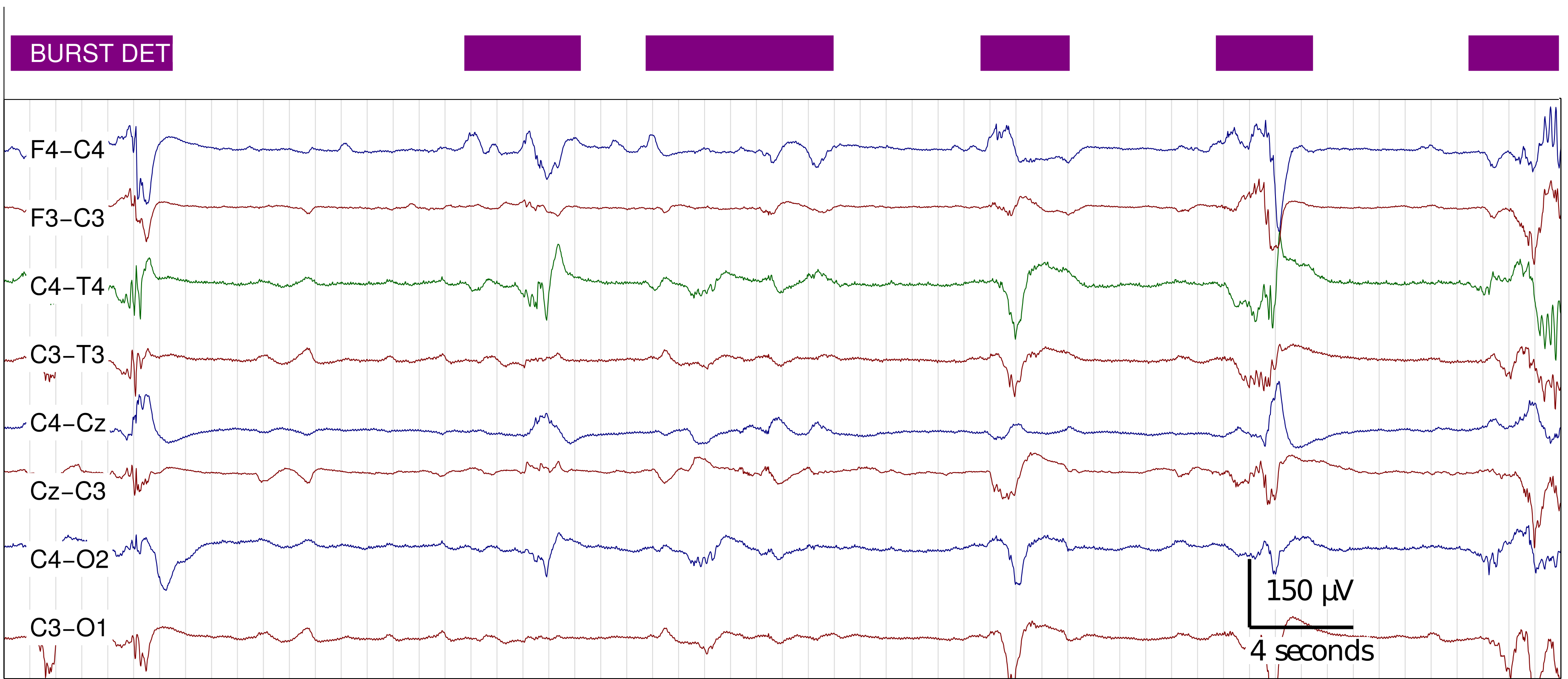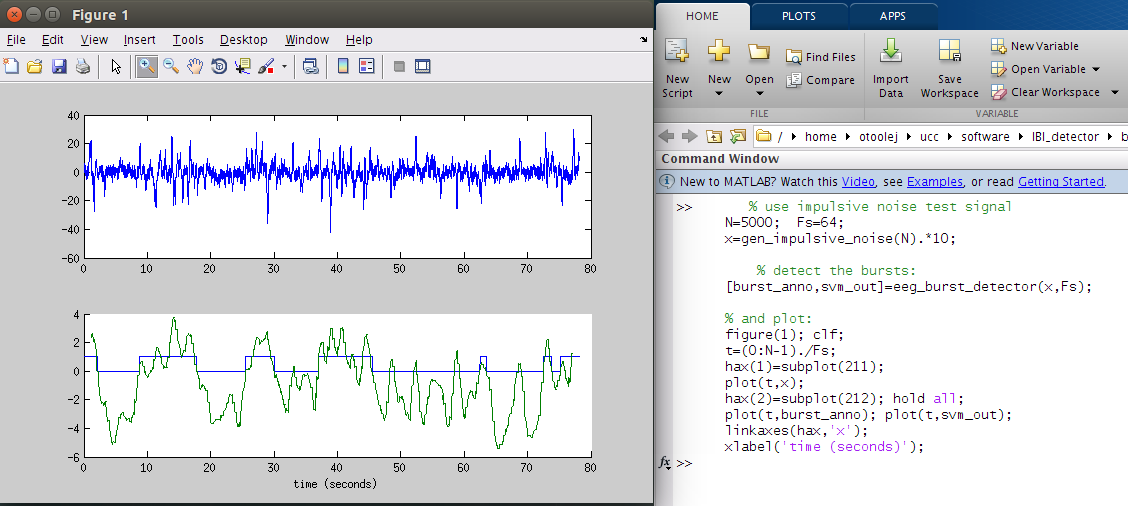Method to detect bursts in the EEG of preterm infants
Contents
Collection of M-files (computer code) for method to detect bursts in preterm EEG, as described in [1]. Requires Matlab or Octave programming environments.
download
code will be upload after the journal article review process for [1].
overview

A simple method to detect bursts in the EEG of preterm infants. The method was developed by assessing multiple frequency and amplitude features of bursts. Selected features were combined in a classifier (support vector machine). After a feature selection and training procedure, the detector consisted of eight features which are combined in a linear support vector machine. The code here implements this detector, which was trained on annotations from 1-channel of 10 minute EEG recordings from 36 preterm infants.

quick start
First, add paths using the load_curdir function:
>> load_curdir;example
% use impulsive noise test signal
N=5000; Fs=64;
x=gen_impulsive_noise(N).*10;
% detect the bursts:
[burst_anno,svm_out]=eeg_burst_detector(x,Fs);
% and plot:
figure(1); clf;
t=(0:N-1)./Fs;
hax(1)=subplot(211);
plot(t,x);
hax(2)=subplot(212); hold all;
plot(t,burst_anno); plot(t,svm_out);
linkaxes(hax,'x');
xlabel('time (seconds)');
files
All Matlab files (.m files) have a description and an example in the header. To read this
header, type help <filename.m> in Matlab. Directory structure is as follows:
├── bd_parameters.m # parameters for the method are defined here
├── eeg_burst_detector.m # burst detector for multi-channel EEG
├── estimate_features
│ ├── edo.m # envelope--derivative operator
│ ├── env.m # signal envelope (using Hilber transform)
│ ├── fd.m # fractal dimension (using Higuichi method)
│ ├── if_.m # instantaneous frequency (using CFD estimate)
│ ├── psd_r2.m # fit of linear regression to log-log spectrum
│ └── rel_spec_power.m # relative spectral power
├── gen_features.m # generate features
├── load_curdir.m # load the path
└── utils
└── do_bandpass_filtering.m # bandpass filtering (IIR filter)
├── epoch_window.m # epoch window size and hop lengths
├── get_window.m # generate epoch window
└── gen_impulsive_noise.m # impulsive noiserequirements
Either Matlab (R2013 or newer, Mathworks website) or Octave (v3.8 or newer, Octave website, with the ‘octave-signal’ add-on package).
test computer setup
- hardware: Intel(R) Xeon(R) CPU E5-1603 0 @ 2.80GHz; 8GB memory.
- operating system: Ubuntu GNU/Linux x86_64 distribution (Vivid Vervet, 15.04), with Linux kernel 3.19.0-30-generic
- software: Octave 3.8.2 (using Gnuplot 4.6 patchlevel 6), with ‘octave-signal’ toolbox, and Matlab (R2013a)
licence
Copyright (c) 2015, John M. O' Toole, University College Cork
All rights reserved.
Redistribution and use in source and binary forms, with or without modification,
are permitted provided that the following conditions are met:
Redistributions of source code must retain the above copyright notice, this
list of conditions and the following disclaimer.
Redistributions in binary form must reproduce the above copyright notice, this
list of conditions and the following disclaimer in the documentation and/or
other materials provided with the distribution.
Neither the name of the University College Cork nor the names of its
contributors may be used to endorse or promote products derived from
this software without specific prior written permission.
THIS SOFTWARE IS PROVIDED BY THE COPYRIGHT HOLDERS AND CONTRIBUTORS "AS IS" AND
ANY EXPRESS OR IMPLIED WARRANTIES, INCLUDING, BUT NOT LIMITED TO, THE IMPLIED
WARRANTIES OF MERCHANTABILITY AND FITNESS FOR A PARTICULAR PURPOSE ARE
DISCLAIMED. IN NO EVENT SHALL THE COPYRIGHT HOLDER OR CONTRIBUTORS BE LIABLE FOR
ANY DIRECT, INDIRECT, INCIDENTAL, SPECIAL, EXEMPLARY, OR CONSEQUENTIAL DAMAGES
(INCLUDING, BUT NOT LIMITED TO, PROCUREMENT OF SUBSTITUTE GOODS OR SERVICES;
LOSS OF USE, DATA, OR PROFITS; OR BUSINESS INTERRUPTION) HOWEVER CAUSED AND ON
ANY THEORY OF LIABILITY, WHETHER IN CONTRACT, STRICT LIABILITY, OR TORT
(INCLUDING NEGLIGENCE OR OTHERWISE) ARISING IN ANY WAY OUT OF THE USE OF THIS
SOFTWARE, EVEN IF ADVISED OF THE POSSIBILITY OF SUCH DAMAGE.references
-
JM O’ Toole, GB Boylan, RO Lloyd, RM Goulding, S Vanhatalo, and NJ Stevenson, “Detecting Bursts in the EEG of Premature Infants Using a Multi-Feature Approach”, submitted for review, 2015. links: code
-
JM O’ Toole and NJ Stevenson, “Assessing instantaneous energy in the EEG: a non-negative, frequency-weighted energy operator”, In Engineering in Medicine and Biology Society (EMBC), 36th Annual International Conference of the IEEE, pp. 3288-3291. IEEE, 2014 links: paper || poster || code
contact
John M. O’ Toole
Neonatal Brain Research Group,
Irish Centre for Fetal and Neonatal Translational Research (INFANT),
Department of Paediatrics and Child Health,
University College Dublin,
Western Gateway Building, Room 2.17,
Cork, Ireland
